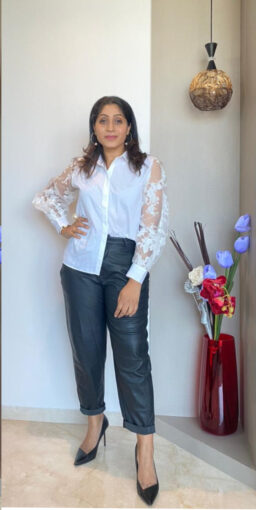Mirror Work
Mirror work has been in vogue for centuries and is popularly known as “Sheesha” or “Abhala Bharat” embroidery. This is an art form in which mirrors of various shapes are fixed on to the fabric through embroidery. In recent times however, mirrors have been replaced by reflective luminescent metal pieces of different shapes and sizes, particularly on apparel. Mirror work is used on various fabrics such as georgette, crepe, cotton, silk, chiffon and many more which are then turned into attractive apparel and accessories ranging from sarees, to cushion covers and belts. Sheesha or mirror embroidery is traced back to 17th century in Iran and it is said to have been brought to Indian through various travelers during the Mughal era.Mirror work was patronized by the states of Rajasthan, Gujarat and Haryana, hence these three states form the major hubs for mirror work. However, this embroidery can be found in various other parts of the country as well.
Chikankari
Chikan, in the literal sense means ’embroidery’. This traditional embroidery style is one of Lucknow’s most ancient and well-known art forms, believed to be introduced by the Mughals. The simple and precise handwork on the garment, gives it a very subtle, classy feel that modern embroidery techniques lack. The main essence of the garment is a simple design, and while motifs are now added to make the garment look rich, it still remains a simple and affordable fabric choice.
Started as a white-on-white embroidery form, back in the day, the favoured fabric was muslin or mulmul as it was best suited to the warm, slightly humid climate. After the downfall of the Mughal Empire, chikankari artisans spread all over India, but Lucknow remained the main center, with Awadh a close second.
Kantha Embroidery
Kantha, a popular style of embroidery that comes from West Bengal, is a significant symbol that displays the skill and talent of the rural women in Bengal. Kantha, which basically means ‘throat’, is associated with Lord Shiva. The story revolves around how Lord Shiva consumed poison while stirring up the ocean, and therefore the significance of this word goes all the way back to the Vedic times. This type of stitch is basically the ‘running’ stitch, and is very simple.Traditionally this embroidery was used for quilts, dhotis and sarees, but over a period of time it has evolved and made its way right into the heart of Indian fashion. The yarn is taken from old saree borders; the design is then traced and finally covered `with running stitches. Today this kind of embroidery can be found on shawls, pillow covers,dupattas, and home furnishings as well.
Zardozi Embroidery
Zardozi is form of embroidery that came to India from Persia. Its literal translation, “zar” meaning gold and “dozi” meaning embroidery, refers to the process of using metallic-bound threads to sew embellishment on to various fabrics. This heavy and intricate style of design is said to have been brought to India with the Mughal conquerors.It found a base with thousands of artisans who have passed on this trade among their families and local communities. While the Indian city of Lucknow became a major center for this art form, its exact origin is unknown. However, there are many romanticized stories that surround its origin. Till date there are numerous micro enterprises that specialize in Lucknow zardozi . It is particularly popular in countries like Iran, Pakistan and India.
Lucknow Zardozi has more ornate and heavy designs, with a 3D quality to their motifs. This is a similar style to the Delhi Zardozi work, whereas Hyderabad and Agra tend to keep patterns minimalistic, with a focus on simple but large motifs. The inspiration for all motifs has always been nature. From flowers, leaves and trees to animals and birds, the national ecology of India seeps in to all Zardozi embroidery.
Beadwork Embroidery
Bead embroidery is a type of beadwork that uses a needle and thread to stitch beads to a surface of fabric, suede, or leather.
Bead embroidery is an embellishment that does not form an essential part of a textile’s structure. In this respect, bead embroidery differs from bead weaving, bead crochet, and bead knitting. Woven, knitted, and crocheted beads may be attached during fabric production, whereas embroidered beads are always added upon finished fabric.
Georgette fabric
Georgette is typically a plain weave fabric that is woven using tightly twisted s-twist and z-twist yarns, which are yarns twisted in opposite directions. These twists create slight puckers on the surface of the fabric, which gives Georgette its signature crinkled finish.
Characteristics of Georgette
There are a number of characteristics that make Georgette a unique fabric. These include:
- Lightweight and breathable. Georgette is a light, flowy fabric that is fairly breathable. However, georgette made with synthetic fibers is less breathable than those made with silk.
- Crinkled. Georgette is known for its signature puckered appearance, which is a result of the tightly twisted yarns used in the weave.
- Sheer. Georgette is a sheer, translucent fabric, though it is slightly less sheer than its sister fabric, chiffon, which is more net-like. Learn more about chiffon here.
- Nice drape. Georgette is a very flowy fabric and has a nice structure and drape, particularly for dresses and skirts. Georgette can be layered on top of more solid fabrics to add dimension and create an eye-catching effect.
- Holds dye well. Georgette fabric holds dye nicely, and the natural off-white color of silk can be dyed a variety of hues and patterns.
- Slight stretch. Georgette fabric has some bounce and gives as a result of the weave and tight yarn twists.

Chiffon fabric
Chiffon is a lightweight plain-woven fabric with mesh like weave that gives it transparent appearance. The word Chiffon has a French origin which means a cloth. It is primarily made from cotton, silk or synthetic fibers like nylon, rayon and polyester. Chiffon is most commonly used to weave Sarees, Dresses and Scarves.It is made from silk is the most popular variant of the fabric. The shimmer texture of silk fabric makes the Chiffon look more appealing. Though it is lightweight, the fabric has considerable strength. Due to its manufacturing from natural silk fiber, it is a more expensive than the synthetic Chiffon.The fabric was made exclusively with Silk until Nylon was invented in 1938. After the introduction of Polyester fabric in 1958, the polyester chiffon blend became more popular because of its durability and economic viability.


Organza fabric
From wedding dresses to evening wear to home decor, organza has many versatile and decorative uses. Characterized by its lightweight and slightly shiny appearance, organza is a fixture of both bridal and evening wear markets, building sculptural and flowy gowns with dimensions that are surefire showstoppers.
Organza is a lightweight, sheer, plain-woven fabric that was originally made from silk.
The material can also be made from synthetic fibers, primarily polyester and nylon. Synthetic fabrics are slightly more durable, but the fabric is very delicate and prone to frays and tears.
Organza is also characterized by very small holes throughout the fabric, which are the spaces between the warp and weft thread in the plain-weave pattern.Organza is extremely popular for wedding gowns and evening wear, as it has a shimmery and translucent quality which creates decadent silhouettes.silk organza fabric originated in China, where silk was first cultivated. Organza was traded along the Silk Road, the trading route from China to Europe, and production spread around the world.
China remains the biggest producer and exporter of organza today.

Net fabric
Net has been one of the most sensual fabrics available in the fashion industry. It is used widely to create Indian ethnic attires as well.Net fabric is usually used to create sections of the garment, Or is layered over a sturdier fabric in order to cover the garment in its entirety. It owes its popularity to the mystical aura that it generates when worn.Garments with elements of net can be traced back to ancient India as well as western civilizations. While historically the origin of this fabric remains unclear, it is apparent that it has been used for centuries. In terms of ethnic fashion, the oldest net saree is traced to the pre-Mughal era.
There are many different types of net fabrics that are used in ethnic fashion. These are:Bobbinet,Tulle,Fishnet,Filet Net

Patola
Patola is a double ikat woven sari, usually made from silk, made in Patan, Gujarat, India. The word patola is the plural form; the singular is patolu. They are very expensive, once worn only by those belonging to royal and aristocratic families. These saris are popular among those who can afford the high prices. Velvet patola styles are also made in Surat. Patola-weaving is a closely guarded family tradition. There are three families in Patan that weave these highly prized double ikat saris. It is said that this technique is taught to no one in the family, but only to the sons. It can take six months to one year to make one sari due to the long process of dying each strand separately before weaving them together.Patola was woven in Surat, Ahmedabad and Patan.Highly valued in Indonesia, became part of the local weaving tradition there.
Bandhani
Bandhani, also known as Bandhej; is a type of tie and dye textile which is adorned by plucking the cloth into many bindings, that form a design. Practiced mainly in the states of Rajasthan, Gujarat and some parts of Uttar Pradesh, the word Bandhani is derived from a Sanskrit word ‘Banda’ which means ‘to tie’. The art of Bandhani involves dyeing the fabric which is tightly tied with a thread at several places to produce different patterns.
Bandhej or Bandhani is the oldest form of tie and dye. According to the historical references, the first Bandhani saree was worn many years back, at a royal wedding. Ajanta caves also have a visual representation of Bandhej and this ancient art form is still in practice. Bandhani is generally performed on cotton and silk fabrics.

Silk
Silk is the strongest natural textile in the world. This textile was just recently surpassed in strength by alab-engineered biomaterial, but it remains the strongest fabric made through natural processes.
Despite its immense tensile strength, silk is generally prized for other reasons. Silk’s softness has made it a hotly desired commodity throughout history, and this simple fiber has built legendary trade routes and transformed cultures throughout the Old World.
Different types of silk
Mulberry Silk,Eri Silk, Tasar Silk,Spider Silk,Muga Silk, Sea Silk,Coan Silk,
Satin
Satin is more than just a soft, shiny fabric often used for fancy dresses. A satin weave can comprise many types of fabrics, and its uses number beyond bridesmaid dresses and gowns. Satin refers to the weave, not the textile, and most fabric characterized as satin has a soft, shiny finish that can be seen anywhere from evening bags to upholstery.
Satin is one of the three major textile weaves, along plain weave and twill. The satin weave creates a fabric that is shiny, soft, and elastic with a beautiful drape. Satin fabric is characterized by a soft, lustrous surface on one side, with a duller surface on the other side.
Satin dates back to the medieval China, where it was made exclusively with silk. The weave originated in the Chinese port city of Quanzhou, which was called Zaitun in medieval Arabic, hence the name satin today.









Itís difficult to find educated people about this subject, but you sound like you know what youíre talking about! Thanks